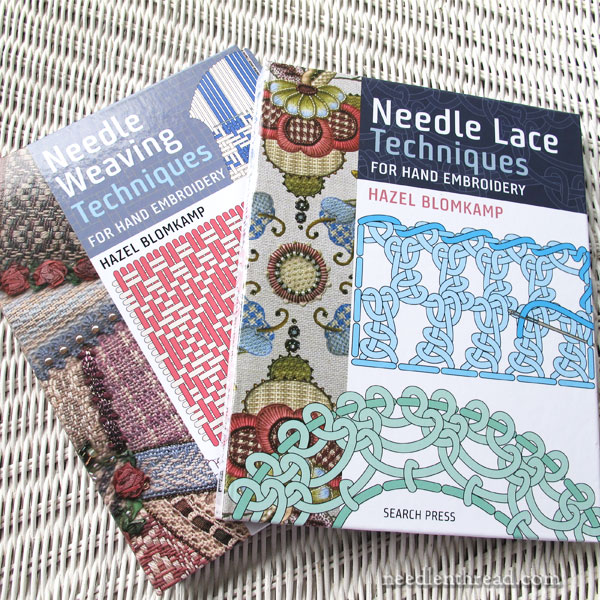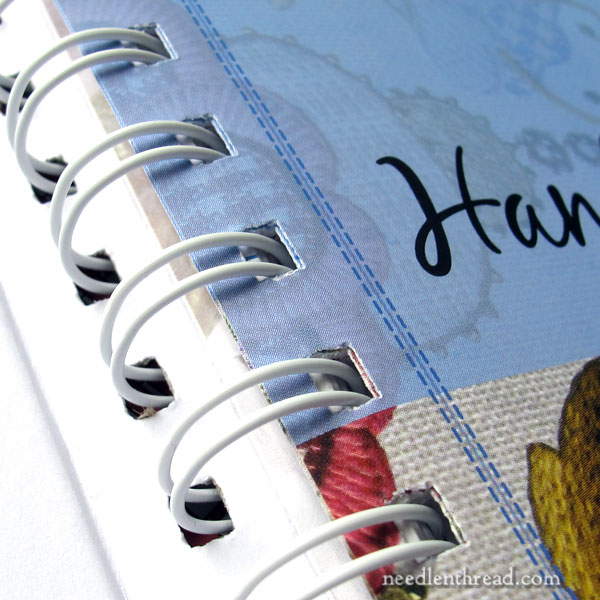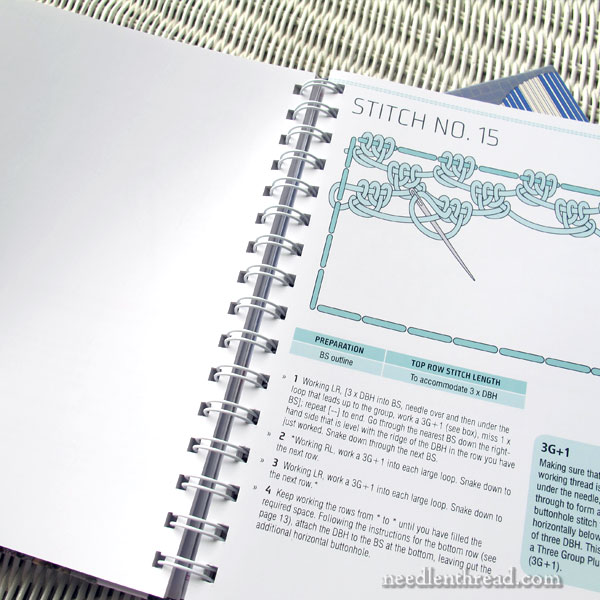Last year, I reviewed Hazel Blomkamp’s handbooks on needle weaving and needle lace techniques, which she was offering on her website as self-published booklets.
Just a heads up! Both books are now being published by Search Press! I’ll show them to you here, let you know what’s different about them and where you can find them, and then we’ll chat a bit about needlework books in general and I’ll share a bit of upcoming news with you. Read on, read on!

If you’re keen to know what kind of content is in both of these handy “work books” by Hazel Blomkamp, please read my review of them from last year.
While the instructional content in the books hasn’t changed, there are a couple notable features in the books now published by Search Press.
One feature is this:

I’m a pretty big fan of this type of “half Canadian binding” on instructional needlework books. The wire binding allows the book to lie flat on open on your work table, so that you can easily reference the book while you’re stitching.
This type of binding allows for printing on the spine, so that it’s easy to see the title of the book while it’s on the shelf, but it offers all the convenience of a wire-bound book, when it comes to using the book.
The books are hard board covers with a glossy finish. They’re very sturdy, and they’re small enough to slip into a project back or basket for easy reference.

On the new editions, you’ll find that only one side of each two-page spread is printed, so that there’s a blank page to the left each time you turn the page.
While it’s tempting to write this off as wasted space in the printed books, in fact, if you’re using instructional books as a work book, there’s nothing better than blank pages. This is where you can take notes on things that work (or don’t work) for you while practicing the techniques, and where you can work out your own stitch patterns and save them for future reference.
I’ve always been a fan of having at least one blank page in instructional books, for note-taking. Since most books don’t have blank pages in them, I resort to an inordinate amount of post-it notes, which are never really permanent, and can be hard to keep track of. With blank pages throughout these two books, you can truly treat them like work books, with the instruction on one side and room to note your own experiences and experiments on the other.
I’ve listed where you can find both books on the original book review article here on Needle ‘n Thread. Just scroll to the end of that article for the list of available sources!
Speaking of Needlework Books
This year, I’ve not really reviewed that many needlework books, although quite a few good ones have been published!
As the year comes to a close, I’ll be reviewing a few more of my favorites from 2017, so that you can make informed decisions about adding them to your library or your wish list.
In fact, the whole purpose of my book reviews is so that you can know what’s in a book and see how it can help you, before you buy it. I like to list pros and cons, and in some cases, I like to supply alternatives that might serve you better for particular techniques or topics.
I’m in the process of updating my Books page, where you’ll find a whole slew of needlework books I’ve already reviewed and links to those reviews. I haven’t updated that page in a while, and I’ll be adding quite a few more review links over the next two weeks.
My plan is to restructure that page and divide the books by categories and techniques, rather than listing them in alphabetical order. I think more people search for books by specific techniques or topics, rather than by title, don’t you? So I’m working on that! If you have any insights about how you think the book page on Needle ‘n Thread should be arranged, feel free to weigh in with your thoughts below!
Want Thread?
Coming up on Friday, I’ve got a delectable embroidery thread give-away for you! Keep an eye out for that – it’s a great way to build your stash and to enjoy the experience of new threads that you may not have tried yet!



